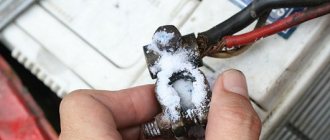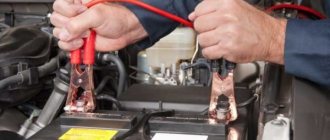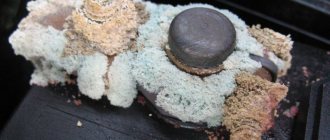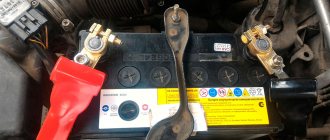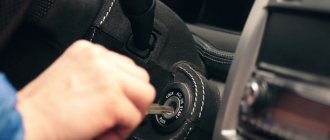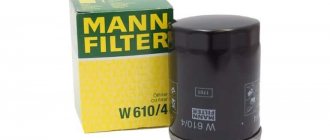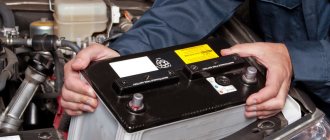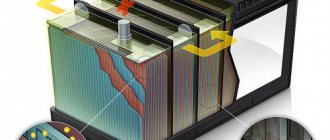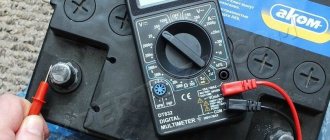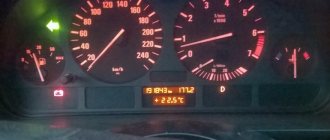Before you understand how you can lubricate the battery terminals, you should understand the question: why lubricate them. And they lubricate the battery terminals of cars so that a white coating (oxide) does not form on them. The oxidation itself occurs from electrolyte vapors and under the influence of other aggressive environments, which include air (it contains oxygen). The oxidation process is invisible at first, but negatively affects the operation of the battery. So much so that it can begin to quickly discharge (due to current leakage), there will be a problem with starting the engine, and then you will have to completely restore the terminals. Want to avoid this?
Bad battery or poor contact with the battery?
Really, why won't the car start? The most common reason is the battery. The car does not have enough voltage-current-charge, the starter clicks, but the car does not start. Battery, right? Yes, but not really. There are nuances:
1. The battery is really dead.
A kind person with a cigarette lighter cord will help you start the car, or you will have to connect the charger for 15 minutes, or a newfangled capacitor device found in your neighbor’s garage will help. We set off, but the question remained: “Why did the battery die?” There are two options here:
- Maybe the battery has really expired, it doesn’t hold voltage, has a high self-discharge, etc. Charging doesn't help for long.
- The battery has discharged something, and after charging it, the car starts with a bang. We need to look for the reason. Besides the banal ones (the lights were on all night), there is one reason that even experienced drivers sometimes forget about: self-discharge directly into the dirty body. We will return to this reason shortly.
We recommend reading the article on how to extend the life of your battery.
2. The battery has a decent charge, but there is not enough current.
This means there is poor contact in the battery terminals, where the wires to the body and the starter are attached to it. And here are two options:
- The clamp on one or both terminals of the battery is simply not tightened, it dangles, and is easily turned by hand. Turn it a little in one direction or the other, pressing down so that it sits deeper, tighten the bolt and - go ahead!
- The contacts have oxidized, or even become completely covered with an unsightly layer of oxides. Oxides do not conduct electric current well, and their layer can greatly increase the resistance of the starter power circuit, making the normal starting current unattainable. To leave, clean the terminal and clamp with improvised means (knife, rag), attach the clamp, slightly twisting it (as in the previous case) and tighten it. The car should start.
But remember, this is only a temporary measure, and the battery persistently requires your attention.
There is a video waiting for you at the very end of the article!
General reason or a little theory
Self-discharge and oxidation of contacts,
turns out to be interconnected. The reason for these phenomena is the combination of water, dirt (dust) and sulfuric acid from the battery itself on the surface of the battery and its contacts.
Sulfuric acid
- this is an integral part of the electrolyte, it tends to slowly evaporate, this process is called electrolyte leakage (especially when the battery almost boils in the summer under the hood of a hot car), and can also leak where the contacts exit the housing. Sulfuric acid vapor loves water and immediately combines with it, forming a solution of sulfuric acid. Let's remember this.
Dust, dirt, moisture
- they are always under the hood and over time they cover any surface there with a durable coating, including the battery and its contacts. Water holds dust, dust holds water - in general, there is always water in this coating. It dissolves some of the dust, and then in the area of the battery, sulfuric acid is added to it - and this is no longer water, which in its pure form does not conduct electric current, but a conductive solution, an electrolyte, almost the same as in the battery.
It is not for nothing that experienced craftsmen never install or remove a used, not new, battery without protective clothing and gloves. It seems like I didn’t touch the battery with my pants, but lo and behold, a few days later, out of nowhere, a hole appeared. The acid ate away, slowly but surely.
Oxidation of battery terminals
The terminals of most acid batteries are made of lead, the same metal as the filling. Lead easily reacts with sulfuric acid, various salts from the surface wet layer, and is also easily oxidized by atmospheric oxygen. The positive potential of the positive terminal, relative to the environment, only accelerates the destruction of the terminal. That is why it is on the positive terminal that all these multi-colored crystals most often grow.
What to do?
It is good to clean the contact area (until shiny) and the entire clamp with emery cloth, a wire brush or files, rinse with distilled water or gasoline and dry. Lubricate with a thin layer of protective lubricant (there are also recommendations to apply protection only after connection). Place the clamp with a rotating motion to remove grease from the contact area. Tighten the bolts. Additionally, coat the surface of the assembly with the composition.
Remember, protective lubricant compounds only protect, not clean. Therefore, it is up to you to carry out high-quality cleaning, on which the result of the entire operation depends. And the task of lubricants is not to eliminate the consequences, but to prevent them.
Is a lubricant capable of removing oxides from the metal surface?
There is an opinion among beginners that a good lubricant not only protects the surfaces of the terminals, but also removes existing traces of oxidation. This is mistake.
If oxides appear on the connector, applying a special compound (even the most expensive) will do nothing.
The only solution is to remove the tips and clean the terminals until they are shiny, and after connecting, treat them with a special lubricant.
What are the dangers of oxidation?
If you do nothing, the following problems are possible:
- Difficulty starting the engine. This malfunction is typical for cars of domestic brands. Most often, the “positive” terminal suffers, which turns out to be contaminated.
- Decrease (dip) in on-board network voltage during engine start-up. When you turn the ignition key, the starter consumes more than 100 Amperes of current, so even insignificant resistance creates problems and “pulls” the voltage onto itself.
- The effect of self-discharge of the battery occurs. The reason is the appearance on the surface of the product of an oxide film capable of conducting electric current.
It is better to treat and lubricate the terminals in advance, even on a new battery, without waiting for oxidation to appear.
If the terminals are covered with “white salt” after cleaning, either cracks have formed around the terminal or that overcharging is occurring. Lubrication will not help in this case.
What do oxide films lead to?
The formed oxide film does not provide the contact area required by the vehicle design, which does not allow the required current to be supplied to the starter. For example, when starting a cold engine in a passenger car, the current reaches values of more than 200 A. If the contact zone is oxidized, then the current passed will not be enough to crank the engine crankshaft.
An additional problem with terminal oxidation is local overheating of the contact pads at the time of start-up. The passing current of high strength heats the area to the melting point of lead alloys, which leads to the destruction of the battery and electrical wiring of the car.
Oxide films and electrolyte drips form paths connecting the battery poles and accelerating the self-discharge process.
As a result, the current source loses capacity; with deep discharge, degradation of the active mass and plates begins, leading to irreversible damage to the battery.
When to lubricate terminals
It is necessary to lubricate the battery terminals not when a layer of white oxide has already appeared, but preferably before installing the battery or at least at the very beginning of the process and the appearance of oxidation products. Before lubrication, the terminals must be cleaned!
On average, terminal maintenance measures are required every two years. On modern maintenance-free batteries that do not require so much attention, the need to lubricate the terminals may arise after 4 years.
By and large, it all depends on environmental conditions and the condition of the electrical wiring. Since damage to the terminals, poor contact, overcharging from the generator, violation of the seal of the housing and the ingress of technical fluids only contribute to the formation of plaque.
Disadvantages of using Litol and similar materials
Litol has been used as a lubricant for battery terminals for over 45 years.
Since it is a waterproof material, its use is quite justified on battery terminals. This composition of conductive elements protects the surface from the formation of “scale”. The widespread use of Litol was caused by the lack of special lubricants during Soviet times.
However, with the advent of imported products, Litol's popularity decreased.
The fact is that this material, like other outdated products (such as solidol or cyatima), has the following disadvantages:
- Over time, under the influence of high temperatures and other factors, they harden, forming an additional insulating layer when they get into the gaps, increasing the resistance of the transition contact
- The loose structure does not allow for long-term protection; when using car shampoos, such lubricants are easily washed off
- Contains no special additives
How to clean terminals
Felt
— with its help, remove the layer of oxidation products from the terminals. Resistant to acids, very convenient for removing oxidation products. It will also be useful if you protect the battery terminals from oxidation with felt washers soaked in one or another lubricant.
Weak soda solution
— high-quality removal of oxides is the basis for the fact that you will not need to remove the white coating again soon.
Sandpaper
- It is recommended to use fine-grained sandpaper. Although it wears out quickly, it does not leave abrasive particles on the surfaces being treated.
Metal brushes
— their body is made of high-quality wood, there is a hole for a handle.
Cleaner brushes
- a double-sided device, which greatly facilitates the work, and the drill will also make it quicker.
Metal brush Terminal brushes Terminal scraper
Cleaning as a method of struggle
The simplest and most reliable method is timely removal of plaque and cleaning the battery terminals.
Technical advice: no matter what means you use to protect the battery terminals, at least once every six months (preferably at the borders of the winter and summer seasons), clean the terminals mechanically.
This will protect you from problems with starting the engine, leakage processes and heating of the contacts. In order to clean them, you need to unscrew the crimp bolts, preferably completely, and disconnect the terminals. Then moisten them with an alcohol-containing liquid and wipe dry.
If this is not available, you can use a solvent diluted with water. This is more fireproof and also reduces the aggressiveness of the solvent.
To remove possible remnants of ingrained acid from the terminals, you must use a soda solution (a tablespoon of soda per glass of water). If the acid actually came into contact with the metal, small bubbles will appear during the treatment with a sponge or rag soaked in the solution. After washing with soda solution, wipe the terminals with a damp cloth.
Under no circumstances should you use WD products for cleaning. In addition to oil, they contain conductive aggressive cleaning agents of unknown composition to the consumer. WD products are highly undesirable for processing electrical contacts.
Also, acetone should not be used to treat electrical contacts; it even corrodes metals.
Next, cleaning is carried out using fine sandpaper, or on paper. Pre-treatment of heavily soiled terminals can be done with a metal brush. There are special brushes available for sale for such work.
Video - how to clean battery terminals:
The ideal result of the work is a shiny surface, not necessarily perfectly smooth. Lead is a soft material, so when crimping the terminals, the contacts will receive maximum contact.
After carrying out mechanical cleaning work, a natural question arises: how to maintain the ideal condition of the contacts during the period between routine maintenance? The answer is simple: protect the terminals from aggressive substances using various materials.
For this, various lubricants and other materials are used.
Old-fashioned methods of lubrication of terminals
In those days, they didn’t sell a variety of beautiful tubes of auto chemicals. What was available, at hand - that’s how we dealt. These methods still work today.
- Felt and oil
- Indeed, from our grandfathers, the method has been known for a long time. A ring of the required dimensions is cut out of thin felt, soaked in machine oil and put on the cleaned terminal. The clamp is put on with a twist to increase the contact area. Sometimes the top of the knot was covered with an additional plate of oiled felt. The entire surface of the metal was lubricated with oil. - Consistent oil
- If liquid machine oil was used in the previous method, then the entire contact assembly was covered with thick oil - grease, lithol, nigrol, petroleum jelly, without felt. There is a certain difference of opinion here - some consider this method to be the best, while others accept it as a temporary measure until it becomes possible to use a modern means. Of course, this is not what oil is intended for. But if you clean and recoat the contacts twice a year, the method works. - Copper grease
- Both the grease is rare and the method is rare - but effective due to the special properties of copper grease. These are stability of characteristics, viscosity, antioxidant properties. - Wax (paraffin)
is an effective option; it is a good dielectric and also adheres well to the surface of terminals and clamps. - Silicone
is a material that can be given a variety of properties. As a terminal agent it has certain advantages. Silicone is resistant to aggressive environments and water, and can operate at temperatures from -60°C to +180°C. It is important that it is silicone grease without conductive additives.
Silicone coating requires constant monitoring and frequent processing.
People's rating of the best remedies
Among the huge number of products on the market, we will highlight the most popular, time-tested protective lubricants for terminals.
HSC Plus from Molykote
Electrically conductive lubricant based on mineral oil with a thickener, containing metal powder. Works in a wide temperature range. Available in paste and aerosol form.
Ciatim 201
Universal instrument lithium grease, frost-resistant and refractory, inexpensive.
Batterie-Pol-Fett from LIQUI MOLY
Special lubricant for battery terminals. Synthetic acid-resistant Vaseline, red in color. Completely blocks the access of moisture to the contact area. Reduces contact resistance.
Battery Pole Spray by Berner
Specialized aerosol for battery terminals. Improves contact. Well protects against corrosion.
MC 1710 from VMPAVTO company
Lubricating paste for terminals. Apply only to the dressed terminal. Protects against corrosion (contains additives), creates a protective film.
BATTERIE-POL-SCHUTZ from Presto
Protective aerosol. Does not allow sliding discharges, protects against corrosion. Blue color.
Kupfer-Spray from LIQUI MOLY
Universal copper spray for high temperature connections, also suitable for terminals.
